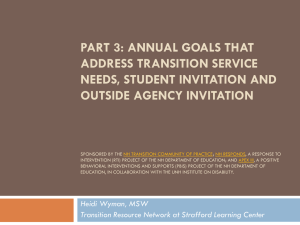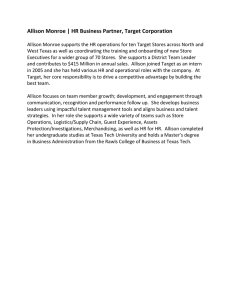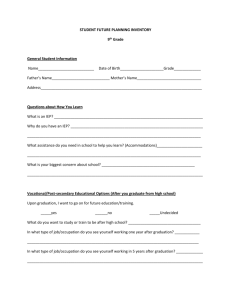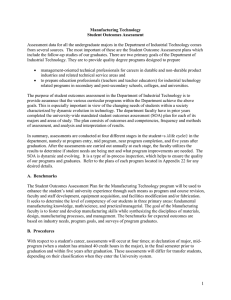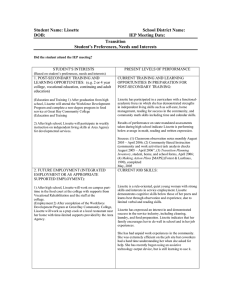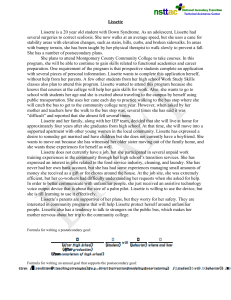PART 1: DEVELOPING MEASURABLE POST SECONDARY GOALS AND AGE APPROPRIATE TRANSITION ASSESSMENTS
advertisement
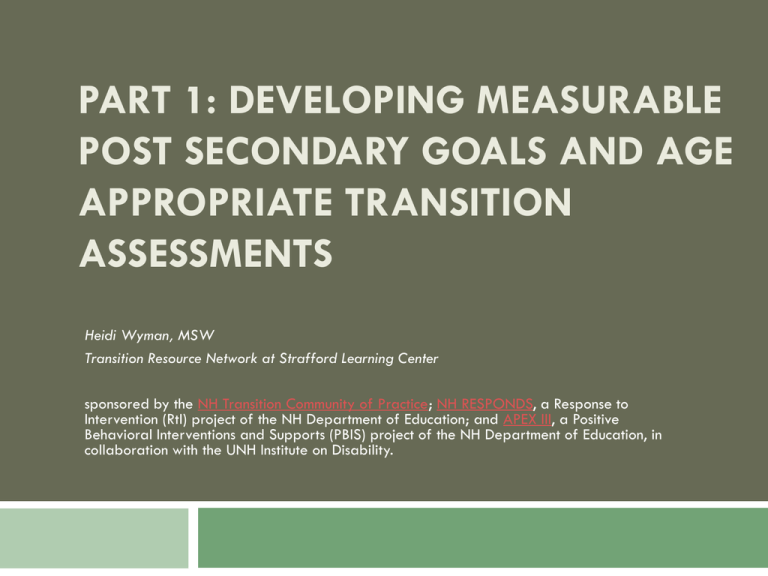
PART 1: DEVELOPING MEASURABLE POST SECONDARY GOALS AND AGE APPROPRIATE TRANSITION ASSESSMENTS Heidi Wyman, MSW Transition Resource Network at Strafford Learning Center sponsored by the NH Transition Community of Practice; NH RESPONDS, a Response to Intervention (RtI) project of the NH Department of Education; and APEX III, a Positive Behavioral Interventions and Supports (PBIS) project of the NH Department of Education, in collaboration with the UNH Institute on Disability. Credits & Recognition National Secondary Transition Technical Assistance Center (www.nsttac.org) Dr. Ed O’Leary and the Transition Outcomes Project NH Transition Community of Practice Institute on Disability NH RESPONDS and APEX III projects NH Dept of Education Strafford Learning Center Parent Information Center agenda Overview Case studies Common Challenges Meeting Facilitation Youth Engagement Initiating Difficult Conversations Review of Definitions, IEP Placement, Indicator 13 Compliance Measurable Post Secondary Goals Age Appropriate Transition Assessment Indicator 13 Compliance Measurable Post Secondary Goals vs. Annual Goals Avoid “transition goals” to avoid confusion Required in the areas of Education/training Employment Independent Living, if applicable 6 Age Appropriate Transition Assessment Part of an ongoing process Formal and informal Individual’s needs, preferences, and interests Related current and future working, educational, living, and personal and social environments. Assessment data serve as the common thread in the transition process Forms the basis for defining goals and services to be included in the Individualized Education Program (IEP)” (The Division on Career Development and Transition (DCDT) of the Council for Exceptional Children p. 70-71). Types of Transition Assessment behavioral assessment information aptitude tests interest and work values inventories intelligence tests achievement tests personality or preference tests career maturity or readiness tests self-determination assessments work-related temperament scales transition planning inventories student interview futures planning observation When, where and how? Age Appropriate Transition Assessment Timeline www.nsttac.org/products_and_resources/Transition AssessmentImplementationTimeline.pdf Indicator 13 Compliance Indicator 13 and IDEA 2004 Transition-driven IEP vs Transition Plan Today will cover IEP elements considered in I13 Checklist items 1-3. Approach I13 compliant case studies by NSTTAC Using NHSEIS forms Read case studies, look at PSG statements, and AATA, and think about AATA for prior and future years Case Studies 1. Allison 2. Lissette 3. Lilly Case 1. Allison Read Case Study Current Post Secondary Goals (Education and Training 1) After graduation from high school, Allison will attend a 4-year Liberal Arts College and take coursework leading to a major in the area of Child Development. (Education and Training 2) The summer after high school, Allison will take a course in first aid and CPR and obtain certification through the local red cross. (Employment 1) After graduation from college, Allison will become an early childhood education teacher in the public schools in her community. (Employment 2) The summer after high school, Allison will work parttime at the child development center near her home. Age Appropriate Transition Assessments •Record of student grades throughout high school, indicating a B average throughout high school (9th through first half of 11th grades) and a statement of how her GPA meets the minimal requirements for entry into college •Scores from curriculum-based measurements that indicate Allison’s level of performance in English and math and a statement describing how her level performance is acceptable for admission into college •A statement by Allison, gathered during an informal interview, recorded on the IEP regarding her interest in attending a university to pursue a degree in Child Development. • a summary of student Psychological test scores obtained during her 3-year reevaluation in the spring of 10th grade indicating specific learning disabilities in reading comprehension and written expression •End of grade test scores from the end of 10th grade demonstrating her participation in the standard course of study with passing scores of 3’s (on a 4-point scale) in reading and math and a statement of how she has met the graduation requirements for statewide testing NHSEIS How it should look in NHSEIS How do we get here? What age appropriate transition assessments might Allison have participated in before arriving at these statements? As a freshman who’s said she wants to go to college but doesn’t know for what purpose? When she expressed doubt about having job skills? What’s next for an 11th grader going on to college? Case 2. Lissette Case Study Current Post Secondary Goals Education and Training 1) After graduation from high school, Lissette will attend the Workforce Development Program and complete a non-degree program in food service at Montgomery County Community College 2) After high school, Lissette will participate in weekly instruction on independent living skills at Area Agency for developmental services. Employment 1) After high school, Lissette will work on campus part-time in the food court at the college with supports from Vocational Rehabilitation and the staff at the college. 2) After completion of the Workforce Development Program at Montgomery County Community College, Lissette will work as a prep cook at a local restaurant near her home with time-limited supports provided by the Area Agency. Independent Living 1) Upon completion of high school, Lissette will utilize public transportation, including the public bus and uptown trolley with time limited supports provided through Vocational Rehabilitation. (2) After high school, Lissette will live semi-independently with a roommate in a assisted living apartment with supports provided through Area Agency. Age Appropriate Transition Assessments Classroom observation notes monthly August 2005 – April 2006; Community Based Instruction (community and work activities) task analysis checks August 2005 – April 2006”, Transition Planning Inventory, student, home, and school forms, April 2006; Making Action Plans [MAPS] (Forest & Lusthaus, 1990), completed May, 2005 NHSEIS What it should look like in NHSEIS How do we get here? What age appropriate transition assessments might Lissette have participated in, in the years leading up to her current experiences? When she expressed strong desire to attend college? When she expressed desire to work, but not sure in what? After a series of surgeries designed to improve mobility? Case 3. Lilly Case Study Current Post Secondary Goals Education and Training After graduation, Lilly will participate in an area agency-based program with an adult curriculum focused on gaining maximum social communication, daily living, and vocational skills. Employment After graduation, Lilly will participate in an area agency-based program with an adult curriculum, receiving services to increase her stamina and mobility to prepare her for work. Independent Living After graduation Lilly will use an augmentative communication device at home and the area agency based program to communicate her wants, needs, and desires and to interact with her environment more independently. Age Appropriate Transition Assessments Anecdotal records for an observation period of 10 days A portfolio assessment Notes in the permanent folder document regarding augmentative communication devices since elementary age Results of a physical therapy evaluation Signed examination summary from Lilly’s pediatrician, dated during the current year NHSEIS What it should look like How do we get here? What’s next? What age appropriate transition assessments might Lilly have participated in, in the years leading up to her current experiences? When school team members expressed doubt that she communicated at all? What’s next? Meeting Facilitation Youth Engagement Initiating Difficult Conversations Meeting Facilitation Have an agenda Make clear what you expect to cover “Here’s how much time we have, what we have to cover” Any other priorities? Consider changing the format of your meeting to START with transition (sample agenda) Preparation: Make some advance phone calls Get AATA data (transcripts, summary of in class or work experiences) Youth Engagement To get their input: Start before you NEED the information Build trust, give student time to think. Then follow up. Try not to be thrown off by “red herrings” Come up with transition services to address their barriers to being able to talk about the future Could anxiety = counseling? Could lack of vision = exploration activities Enlist help from individuals that the young person trusts Have students actively participate! Youth engagement, student development, selfadvocacy…..all different ways of saying “Young people taking charge of their own lives!” We’ve all had to learn how to speak in front of a group. Give students some ideas of where to start. Sample Script Initiating Difficult conversations What do I mean by difficult conversations? “Her parents really want her to attend college and I don’t think that she’ll be able to handle it.” “He should pursue a certificate of attendance. There’s no way he’ll be able to handle unmodified content.” “If she’s going to college, we should not be modifying her course content. But that might hurt her grades. She’s so proud of her honor roll status.” “He’s coded “speech and language”. Shouldn’t we get the parents to change that so he can get more services as an adult?” Initiating Difficult conversations Purpose of initiating should be to make planning progress Where are they coming from? Avoid your assumptions about “common knowledge” Globalize concerns (“a lot of young people feel that way/act that way) while appreciating unique concerns (“that must be very worrying”) Building trust Repetition Course of study discussions Understand the grief cycle Parent Feelings Shock Depression Denial Guilt Shame Acceptance Hope Bargaining Anger Panic Isolation Parts 2 & 3 Using these same case studies: Courses of Study Transition Services ELO’s and Work-based Learning Eligibility and accessing NH services Annual Goals that address transition service needs THANK YOU!!!!!!!!

